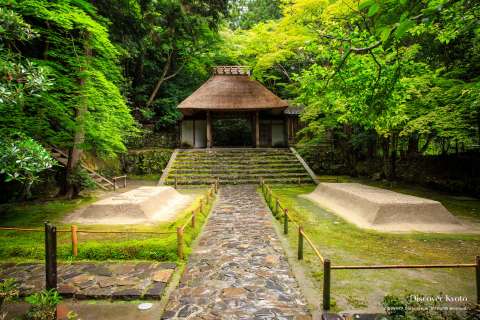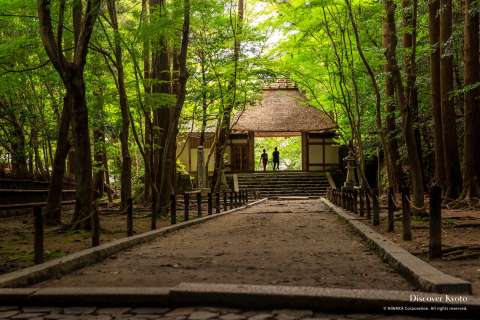Hōnen-in|法然院
Overview

A small temple accessible as a quick detour from the scenic Philosopher’s Path, Hōnen-in is an independent Buddhist temple that possesses a removed and calm atmosphere. Not many tourists come to this neck of the woods outside the popular fall leaf viewing season, so the grounds are relatively peaceful. The most charming point is the thatched-roof main gate and two sand art constructions just inside. Unlike most sand gardens you’ll see in Kyoto, these two patches of sand have been raised and compacted with designs etched in to the top that vary by season. A small pond crossed by a stone bridge lies on the straight path from the gate, but deviating to the left will take you to a carved stone stupa and an interesting modern art installation. The actual buildings on the property are only open to the public once in spring and once in fall, but walking along the edges of it will bring you to the worship hall and a statue set in to a small cave. More than what you can see directly, enjoy Hōnen-in for the peaceful break it can give you.
More than what you can see directly, enjoy Hōnen-in for the peaceful break it can give you.
Features
Thatched Gate

Hōnen-in’s Sanmon Gate is a small, thatched roof construction absolutely covered with moss and ferns and surrounded by draping maple trees. The gate really adds to the serene, removed feeling the temple usually possesses, tucked away in the foothills of Mt. Nyoigadake.
An interesting little note is the carved stone marker remaining to the side of the gate that reads “no garlic, meat, or alcohol beyond this point”, all of these being banned for the more strictly adhering Buddhists in the past.
Byakusadan

The most original feature of this temple is the two sand gardens on either side of the path through the temple grounds. Called the Byakusadan, these two gardens are dominated by large rectangles of raised sand packed hard to maintain shape with designs traced in the sand decorating the top. The designs are usually seasonal and change every week or so.
Representing water you would usually use to cleanse yourself before entering a temple, this pale sand is often photographed and admired.
Hōnen-in “Sanga”
“Sanga”, a Sanskrit word usually translated as “community”, is often used to describe the Buddhist monastic collective. At Hōnen-in the chief abbot is well known in Kyoto for his passion regarding this sense of community, and holds Sanga multiple times each month, detailed on the temple website and published on flyers available at the temple itself. Ranging from symposiums on Buddhism to tea ceremonies, concerts, and art exhibitions, Hōnen-in is made into a gathering place for Kyoto artists, lovers of culture, and learners. However, be advised that these “sanga” are all in Japanese.
History
Named after the founder of the first independent Pure Land school of Buddhism (Jōdō-shū), this temple was established to honor Hōnen (1133-1212), a famous priest and the father of a religious movement that aimed to make Buddhism more accessible to the common people of the time. The Pure Land School’s founder preached a much simpler approach to enlightenment and entry to the Pure Land after death which involved the invocation of Amidha Buddha’s name (nenbutsu), calling on the divinity to save the utterer. However, he counted numerous influential priests of more established schools among his critics, and after an incident in which two of his disciples, Jūren and Anraku, were accused of carrying out the secret conversion of two palace women with lascivious intent, the retired emperor Go-Toba had an excuse to exile Hōnen in 1207.
Allowed to return to Kyoto in 1211 when the ban on his controversial nenbutsu method was lifted, Hōnen then died a year after his return at the age of 78. In 1680, over 400 years after Hōnen’s death, Nincho, the disciple of the 38th abbot of the large Chion-in temple, Banbu, had Hōnen-in constructed on a site where Hōnen had erected a small thatch hut and trained his own disciples in the past.
More recently, Hōnen-in declared its separation from the Pure Land school in 1953 and became an independent Buddhist temple. Literary buffs might find Hōnen-in of interest as the resting place of several prominent figures, including famous contemporary author Tanizaki Junichirō (Naomi, Some Prefer Nettles, The Makioka Sisters).
Events
April 1st – 7th | Spring Special Opening of the Temple Buildings to the Public |
|---|---|
November 1st – 7th | Fall Special Opening of the Temple Buildings to the Public |
December 31st | Jyoya-e New Years Service |
Access
Address
〒606-8422 京都市左京区鹿ヶ谷御所ノ段町30番地
| TEL | 075-771-2420 |
| FAX | 075-752-1083 |
| WEB | http://www.honen-in.jp/ |
Admission
- General Admission: Free (Spring Opening ¥500, Fall Opening ¥800)
- Junior High School, High School Students: Free
- Primary School: Free
Hours
- General Admission: 06:00 – 16:00
- Closed: No closing days
Transportation
Gallery
-




 +8
+8
